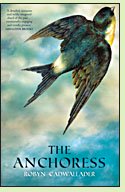The Anchoress
by Robyn Cadwallader
Reviewed by Margaret Tomlinson

An anchoress was a woman who, out of religious devotion, chose to immure herself in a tiny, doorless room alongside a church and remain within for the rest of her life. In medieval Europe, anchoresses were not uncommon. A woman like Julian of Norwich might be revered for her spiritual wisdom even to this day. Other anchoresses may have gone mad. It's hard for us, today, to imagine such a life. Robyn Cadwallader has imagined it brilliantly, following the experiences of a fictional woman in thirteenth-century England for a little over a year after her enclosure, showing how she adjusts, how being an anchoress changes her, and how she changes her approach to the enclosed life.
Readers may find Sarah hard to like at first: she is a medieval woman with a medieval woman's fears and prejudices, and her form of piety is one that, today, gives the impression of mental imbalance. As the novel progresses, the reasons for her choice become clearer and more understandable, and not only from a religious perspective. Sarah is far from saintly, but she grows during her first year of enclosure, learning a compassion she lacked on entering her anchorhold.
The novel also follows Ranaulf, a priest who becomes Sarah's confessor. His misogyny is challenged as he - and the reader - learn more about Sarah's life, past and present. Other characters round out the story; if an anchoress lived in a room no other person entered, she was nonetheless surrounded by people: the clergy and worshippers in the church to which she was attached, the maids who attended to her needs, curious children, and villagers seeking religious consolation or someone in whom to confide their troubles. Sarah's strange and difficult life also has a strange richness that makes The Anchoress an absorbing story. (2015, 308 pages)
More about The Anchoress at Powell's Books or Amazon.comOther novels about anchorites:
Illuminations by Mary Sharratt (2012), about the twelfth-century German anchorite Hildegard of Bingen. See review or more info at Powell's Books
Julian's Cell by Ralph Milton (2002), about the medieval English anchorite and mystic Julian of Norwich. More info
Homo Sum by Georg Ebers (1878), about a fifth-century anchorite on the Sinai Peninsula. More info
Nonfiction about anchorites:
Lives of the Anchoresses: The Rise of the Urban Recluse in Medieval Europe by Anneke B. Mulder-Bakker (2005). More info
Anchorites, Wombs and Tombs: Intersections of Gender and Enclosure in the Middle Ages by Liz Herbert McAvoy (2010). More info
The Complete Julian of Norwich by Julian of Norwich (14th century), spiritual writings by the fourteenth-century anchoress Julian of Norwich. More info
At the Movies:
Anchoress
Online:
Solitude and Sociability: The World of the Medieval Anchorite, an illustrated article by Mari Hughes-Edwards
Back to Europe in the 12th-13th Centuries
Back to Directory of Book Reviews